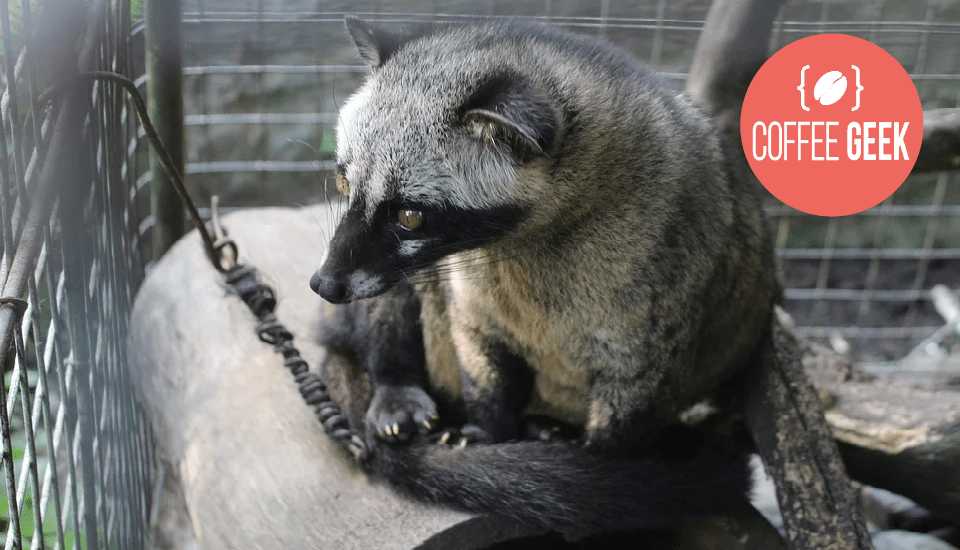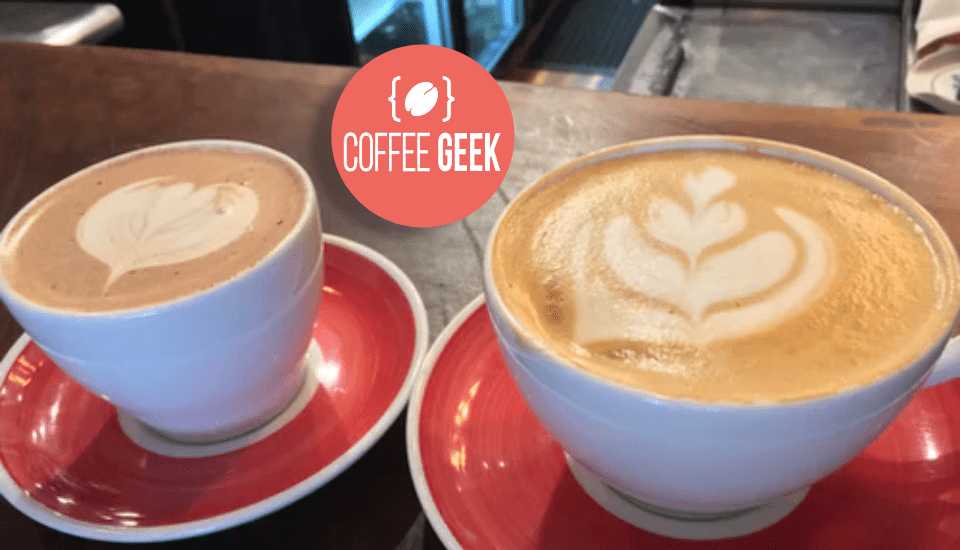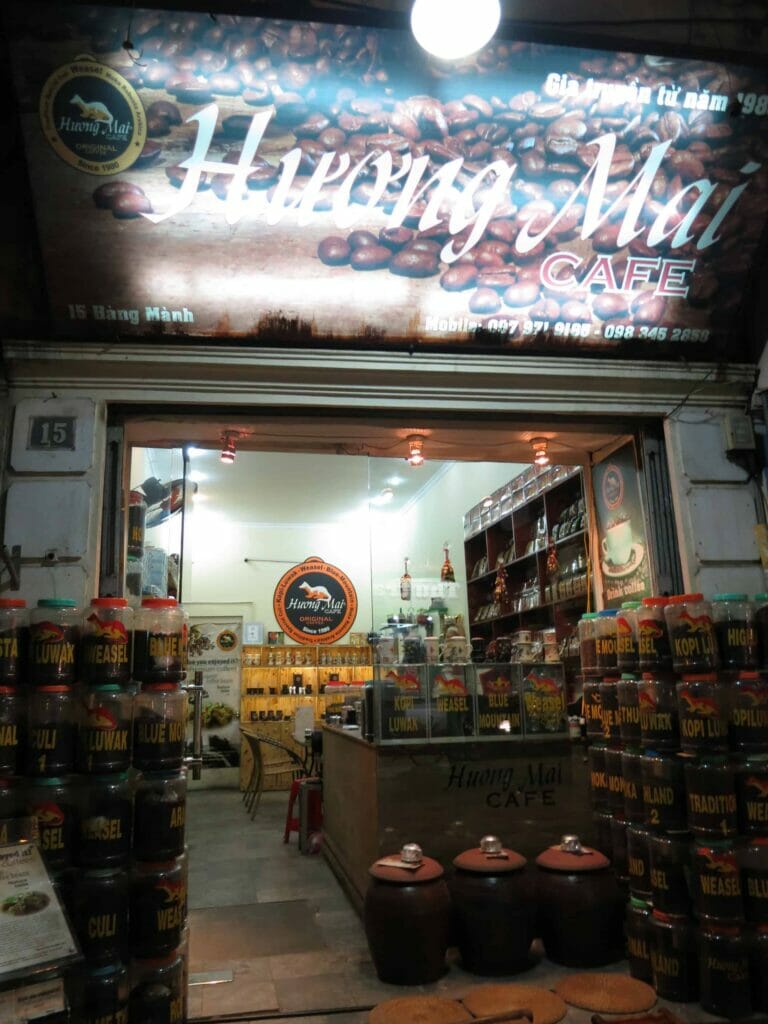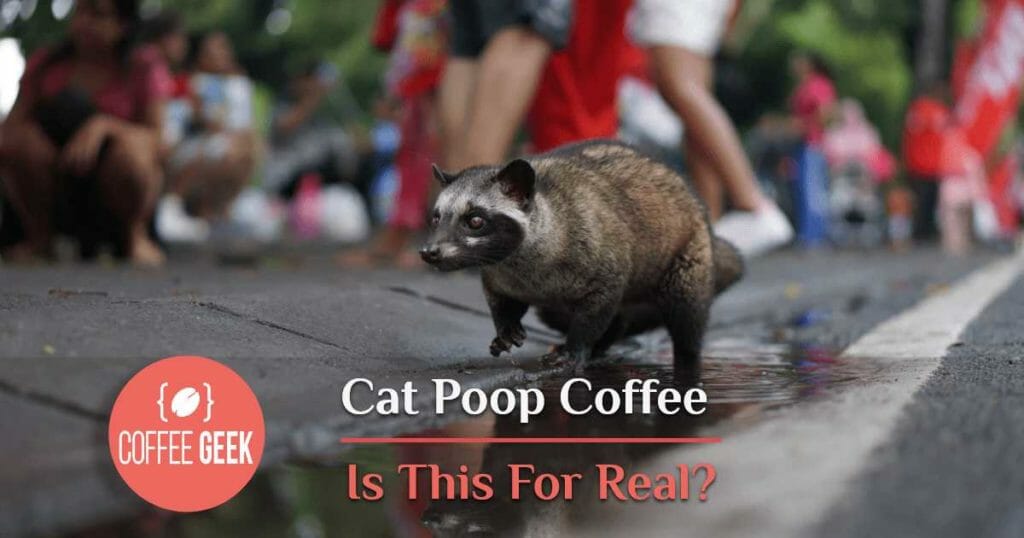Is cat poop coffee real? It is! Cat poop coffee, or kopi luwak, is considered the most expensive coffee in the world, and to use some gangsta slang, some people think that thanks to its unique taste and health benefits, it is “the shit.” Literally.
It is made from coffee beans that were eaten, partially digested, and passed by an animal called the Asian palm civet (Paradoxurus Hermaphroditus), also called the civet cat, luwak, Toddy cat, Marapatti…
What is a civet? It is an animal native to tropical forests, looking kind of like a mix of raccoon, ferret, and a wild cat, weighing around 3 – 5 kg.
Apart from this kind of poop coffee, there is also monkey poop coffee, which originates in Taiwan and India, or Kopi Muncak, a coffee that originates in Indonesia.
In this article, I will closely look at the first one — cat poop coffee, sold as the most expensive coffee in the world, and its taste, pluses, minuses, and controversy surrounding it.
Fun fact: there is actually even more expensive coffee than kopi luwak coffee! Black Ivory Coffee costs up to 1200 dollars per kilogram! Whose dung is it extracted from? Elephants!
- What Is Civet Cat Coffee?
- What Is Kopi Luwak?
- What Countries Is Cat Poop Coffee Popular In?
- How Is Cat Poop Coffee Made?
- Why Is Cat Poop Coffee So Expensive?
- How To Drink Cat Poop Coffee
- What Does Cat Poop Coffee Taste Like?
- Is Cat Poop Coffee Safe?
- Controversy And Ethics Of Cat Poop Coffee
- How To Pick A Conscious Brand Of Cat Poop Coffee
What Is Civet Cat Coffee?
This coffee is a product of colonialism. In the late 1600s, the Dutch governor of India shipped Arabica coffee seeds to the Dutch East Indies (nowadays called Indonesia).
All types of coffee plantations today add up to 1.3 million hectares of land, producing 600,000 tons of coffee beans per year.
Indonesia is the 4th biggest coffee producer in the world and the biggest producer of kopi luwak coffee aka cat poop coffee in the world.1
Why? Because of its long history of coffee production and the fact, that Indonesia is half covered in forests (around 98 million hectares), which are home to many civets, producing kopi luwak.

What Is Kopi Luwak?
Kopi luwak is simply just the Indonesian name for civet cat coffee. Kopi = coffee. Luwak = civet cat.
What Countries Is Cat Poop Coffee Popular In?
Apart from Indonesia (mostly Bali, Sumatra, and Java), it is produced in East Timor, Philippines islands, Thailand, Ethiopia, and Vietnam, where it is called weasel coffee.
One pound costs 100 – 600 dollars and one cup 30 – 80 dollars. Of course, there are cheaper versions, even instant ones. Instant 3 in1 mix costs around 18 dollars for 20 sachets.
The famous Vietnamese brand, Trung Nguyen, costs 16,000,000 VND (690 dollars) per 250g.
How Is Cat Poop Coffee Made?
Asian palm civet eats coffee cherries, that ferment in its intestines, and then the animal poops it out. That is the first unique thing.
Second: palm civet is a gourmet and goes only for the finest beans.
Third: the time spent in the digestive system of said civet removes acidity from the coffee bean.
Some people love it and say it is smooth and fruity, some say coffee loses its nice bitterness.
Why Is Cat Poop Coffee So Expensive?
You need a lot of live animals to produce this coffee, which means a lot of time and land. And even then, you get a limited amount, compared to “normal” coffee.
Then, you need labor and care, because workers need to collect the droppings, remove the beans, wash them thoroughly, then air-dry them, remove the outer skin, and sort. Only the finest ones can be roasted.

The fact that kopi luwak is marketed as the rarest, finest, most expensive coffee also contributes to high prices.
How To Drink Cat Poop Coffee
If you decide to give it a try and make kopi luwak at home, follow these steps:
- Buy a good brand of kopi luwak, ideally whole beans. The popular choice is Arabica wild civet coffee. However, if the civet cat lived in the wild, it can consist of Arabica, Robusta, or Liberica coffee. Civets like all beans. Look into brands of kopi luwak such as Sea Island Coffee, Volcanica, or Sumatera Lintong on Amazon or in specialized stores.
- Civets like all beans. Look into brands of kopi luwak such as Sea Island Coffee, Volcanica, or Sumatera Lintong on Amazon or in specialized stores.
- Know your grind settings and water to coffee ratio. Kopi luwak sellers recommend a ratio of 1:2 for espresso and 1:16 for pour-over. I think I mention it in every article, but invest in a good burr grinder and practice on cheaper beans.
- Use good water. Brew your coffee at around 200 degrees Fahrenheit, no more than 208.
- Never reheat leftover kopi luwak, the taste will just not be the same.
What Does Cat Poop Coffee Taste Like?
There are as many descriptions of its taste as there are people and brands. Most used adjectives are fruity (the citric acid in the stomach gives it a lemony touch), tangy, earthy, choco, syrupy, sweet.
What it lacks in acidity and bitterness it adds in sweet notes and a strong aroma.
Some coffee aficionados say, that kopi luwak it is the worst tasting coffee in the world.
Everyone’s taste buds are different and for some, the image of coffee traveling through an animal’s stomach is just… too much to stomach.

Is Cat Poop Coffee Safe?
Yes, it is washed and roasted so there is the same chance of bacteria presence as with any other coffee beans. And no, kopi luwak coffee does not smell like poop :)
Controversy And Ethics Of Cat Poop Coffee
Many people and organizations think that it is time to “cut the crap.” Why?
80% of Luwak coffee is fake – Sometimes it is a 50:50 mixture of kopi luwak and regular coffee, sometimes it is totally counterfeit. Generally, if the deal looks too good (price is low), beware.
Especially in the center of touristy Hanoi or Saigon in Vietnam, sellers of “ca phe chon” add chemicals into coffee beans to fake the taste of real cat poop coffee, coming from Da Lat and Dak Lak province.
Not sustainable – Civets are omnivores that live in the wild and help to balance the tropical forest ecosystem, as well as disperse the seeds.
However, due to high demand, more civets live in captivity than in the wilderness.
And in bad conditions. Even if they are nocturnal animals, they are exposed to light and noise.
They are often malnourished as farmers do not feed them anything else than coffee cherries.
As I wrote before, in the wilderness, wild civets pick only the finest coffee cherries but farmers, in order to lower the cost feed them low-quality, not ripe, and even old coffee beans.
Previously mentioned Vietnamese coffee brand Trung Nguyen came up with an animal-friendly alternative, Trung Nguyen Legendee Gold Coffee, where an enzyme is used to mimic the taste of Luwak coffee.
Animal cruelty – Palm civets are captured, taken from the wild, put in cages, and overfed unripe coffee beans. They are also being eaten. This for me is a huge turnoff.
Not only are civets endangered, but there were also many cases when civet meat in local markets carried the SARS virus.
Small farmers suffer – While it costs a lot of money, a kopi luwak farmer in Indonesia makes roughly 1 – 3 dollars per day! With any type of coffee, always try to support fair-trade farms.
PETA (People For The Ethical Treatments Of Animals) organization discovered, that many civets not only live in bad conditions, poachers are selling them to farmers even if they are sick, but may also that the SARS coronavirus had jumped from civet cats to humans.
A similar thing happened in Denmark, where 17 million minks had to be exterminated. They buried so many of them, that several started to rise from the ground due to gas, causing a “zombie mink” craze.
How To Pick A Conscious Brand Of Cat Poop Coffee
- Look for civet coffee that was sourced from civets living in the wild – is certified as “wild”
- Avoid cage-sourced kopi luwak
- Look for verified brands, that comply with the Universal Declaration on Animal Welfare (UDAW), and coffee beans from farms acclaimed by specialty coffee organizations, such as SCAI, SCAE, or SCAA
- Buy beans from fair-trade coffee companies, if possible
- Buy kopi luwak in sustainable packaging
With all this written – is civet coffee worth it? I would not buy a kilo of it, but yes, out of curiosity, I tried one cup.
Kopi luwak is marketed as “the most expensive coffee in the world” but I do not think you pay for the taste or experience. You pay for the unique processing method, and sadly, also the suffering of a tiny mammal.
Have you tried kopi luwak coffee? Was this expensive coffee worth it?

